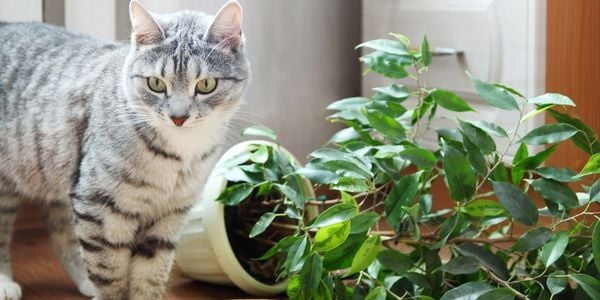
Cats are curious by nature, so it's no wonder that anything moving inside your home becomes potential prey. They also explore with their mouths, making plants a target.
Putting plants around your place can sometimes feel like a sacrificial ceremony (for the plant).
If the leaves or fronds aren't teasing them, some cats enjoy digging or, even worse, defecating in your planter.
Despite the frustration of finding your favorite plants looking like swiss cheese, your cat isn't destroying your decor out of spite. Cats do what they do for a reason. They’re trying to meet a need, which is why it's essential to first understand why your cat may be going after your plants.
Here are tips for troubleshooting why your cat won't leave your indoor plants alone and how to redirect their attention elsewhere.
How to Keep Your Cat From Eating Plants
Why Your Cat Digging In the Plant Pot
How to Stop Your Cat from Using a Planter or Pot as a Litter Box
Why Is My Cat Eating My Plants?
Cats Like the Taste of Plants
Much of a cat's exploration begins through their mouths. It may not sound incredibly enticing to you and me, but even when we were newborns, we experienced many things for the first time in the same way.
As babies, we put everything in our mouths, and cats do the same thing. If it tastes good, it's a safe bet your cat will go back for more.
Hopefully, you've read our article Top 10 Indoor Plants Safe for Cats so you can make sure all your plants are non-toxic to your kitty. This will certainly put your mind at ease if your cat does get to one of them. But, even non-toxic plants can cause an upset stomach or a gastrointestinal obstruction if your cat eats them.
It’s also common for cats to gag or vomit as the leaves or fronds get stuck in their throat. Play it safe and keep your plants out of your cat’s reach, even if they’re non-toxic.
Did you know? Cat tongues are covered in tiny, backward-facing hooks called papillae. Even if your cat doesn’t intend to ingest something like a skinny plant leaf or blade of grass, it can get caught on the papillae and is essentially forced into the throat to be swallowed.
You should contact your veterinarian immediately if you believe your cat is showing any unusual behavior. This could include vomiting, drinking a lot of water, drooling, smacking or licking the lips, gagging, a change in their regular eating habits, or trouble defecating in their litter box.
Cats Like the Texture of Plants
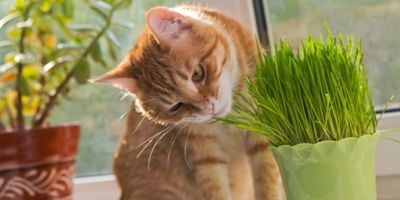
If you've ever taken your cat outside, you may have noticed that they instantly are attracted to long reeds of grass and begin gnawing on it. It could be the texture of the plant that they enjoy.
It's also a possibility your cat has an upset stomach and instinctually is trying to get some fiber to help things move along in their gastrointestinal tract.
Another school of thought is that the tickling nature of the grass in their throat causes them to vomit. This can help with hairballs, though we don’t know if cats are eating grass specifically to cause vomiting or if vomiting happens to be the unintended result.
Cats Love the Movement of Leaves
Cats are natural-born hunters. Although they are carnivores, the movement of a leaf or palm can be nearly impossible to resist. One of our favorite houseplants that are incredibly enticing with their long soft leaves is the Spider Plant. It might be a good idea to dedicate one plant as collateral damage, and this flowy plant could be the one! Just make sure your cat isn't eating it, as any plant, even non-toxic ones, isn't good to be consumed.
Cats Chew Up Plants Out of Boredom
For many cat lovers, it may not be obvious when your feline is fed up with being left alone and struggling with boredom. Cats have always been considered lower maintenance than their canine counterpart, but that's not necessarily accurate.
Not keeping your feline mentally and physically active can lead to destructive behavior. Remember, they’re trying to find ways to meet their natural needs in our homes. If we don’t provide stimulation, they’ll make their own, and your plant (along with other household items) may take the brunt of their boredom.
Click here for DIY cat enrichment ideas and our top picks for enrichment toys!
Cats Eat Plants to Ease Stress
Many cats are prone to stress or anxiety. It can manifest in many ways, including chewing fur, ingesting non-food items, suckling blankets, and, yes, chewing or eating things they shouldn’t, like plants. Watch your cat's body language around the home and especially when they’re chewing. If they seem unsettled or on high alert, you may be dealing with a stress behavior.
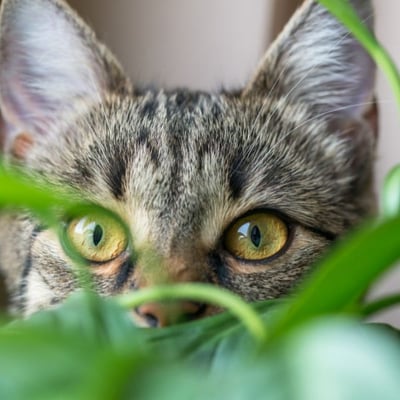
How to Keep Your Cat From Eating Your Plants
Here are some ways that you can make your plants less appealing to your cat and provide appropriate alternatives to meet their needs.
Top Tips to Keep Your Cat Away from Plants
1. Make Your Plants Unappealing
Cats have a strong distaste for anything citrus. Using either juice of a lemon, lime, or orange diluted with some water can be sprayed on the leaves of your plant to ward off any feline invasion.
If you don't feel like creating your own mixture, Bodhi Dog makes a Bitter Lemon Spray. I have found it works really well (and you don't have to worry about using and cleaning out a general-use plastic spray bottle). Usually, if your cat decides the smell is not enough to stop them, the taste will do the trick. That bitter taste keeps them from a return trip.
Safety Note: Don’t rely on this method for plants that are unsafe for cats to eat. It’s not guaranteed to work, and you must reapply the spray often. Also, consider that you can’t contain the citrus smell to just the plant. Your cat may be generally unsettled if the room often smells of something they’re predisposed to dislike.
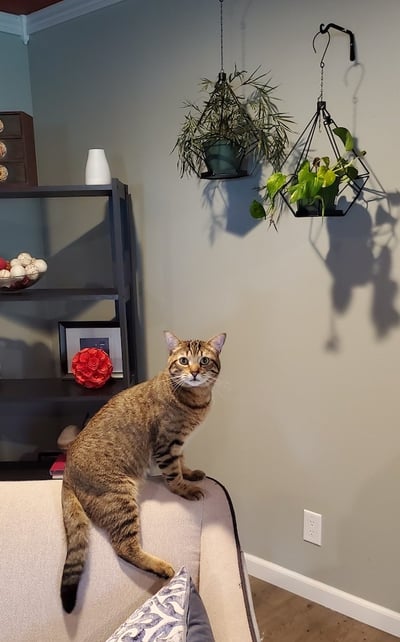 2. Make Your Plants Inaccessible
2. Make Your Plants Inaccessible
There are several places where you can strategically put your household plants to avoid any abuse. Whether you hang them or put them on a shelf high enough that even the best leaper can't reach, it's important to understand your cat and their abilities.
Think outside the box and use an old fish tank for a planter, a terrarium, or a large dome birdcage. They're a little pricey, but it's a great way to keep your plants safe and add some style to the room.
Hang plants from the ceiling or use wall hangers, as our colleague does in her home.
Safety Note: Lilies are toxic to cats, so even having a lily on a shelf or hanging away from your cat does not mean they're safe. Even minor exposures such as floating pollen getting on their fur and them grooming it off can be fatal.
3. Give Your Cat Their Own Plant
Another approach is to provide your cat with their own inside cat garden! Catnip, cat thyme, parsley, valerian, rosemary, and wheat grass are great cat-friendly options. If you grow grass for your cat, make sure it’s safe for them to ingest and ALWAYS keep it cut short. The grains that grow over time can be toxic.
Use small pots so your cat isn’t inclined to dig or eliminate in the soil. And use organic, chemical-free potting soil.
Despite this being a safe alternative, you will still want to monitor how much they consume. We encourage you to talk with your veterinarian about any dietary concerns you may have about cat grass and whether they recommend it as a safe alternative for your cat. And remember, it’s not easy to teach a cat it’s O.K. to eat one plant but not another. So, it’s even more important to keep your other plants out of reach if you’re encouraging them to play with the cat-safe plant.
4. Train Your Cat to Leave Your Plants Alone
Yes, cats can be trained, just like dogs. It does take time, patience, and consistency, but you can train your cats to do nearly anything you want! Some people train their cats to do tricks, while others may leash train their cats, so they can spend more time outside. Teaching your cat to leave your plants alone and redirecting them to an alternative behavior is possible with the right incentive.
The best training method is distracting & redirecting. If you catch them investigating a plant, call them away or pick them up and place them on the floor as neutrally as possible. You don’t want your cat to think this is a good way to get you to engage with them. So, keep it short and sweet. No talking or unnecessary movement. Wait a minute or two, and then redirect them to an appropriate outlet for their energy. Have a quick play session, give them a food puzzle, do a short clicker training session, or pull out a favorite self-play toy.
This will hold their attention, so they’re less likely to go right back to the plant. If your cat is eating your plants due to boredom, you’re meeting that need with the redirection. If they’re eating plants due to stress or anxiety, you’re showing them a better and more effective way to manage that nervous energy.
Dr. Marci Koski of Feline Behavior Solutions suggests finding your cat's motivation when teaching them something new. "Treats are really easy ... because if you give a treat that is small and easily consumable, it doesn't take very much time; you can stay on the whole training process and repeat things over and over. For some cats, it's affection and praise."
Check out our favorite cat treats. Some of them have calming benefits.
Pro tip: If your cat's nefarious nature ends with your plants on the floor – you may want to consider sticky putty for the bottom of your planter. I know that I have it placed under most of our pottery (because kids too)! The best part of sticky putty is that it can be reused; it's non-toxic and doesn't dry out.
Watch how I use sticky putty to prevent my cats from knocking plants and water glasses over.
Why is My Cat Digging in My Planter?
If you have a digger and they're making a mess around your plant, you're not alone! Remember, digging is a natural instinct for a cat.
If you've ever noticed your cat burying their potty deposits, they're doing it for a reason — to hide the scent from predators and their prey. Sure, your inside cat doesn't have to worry about either of those things, but you aren't about to change thousands of years of instinct!
If they are just digging (and not using it as their litter box, which you can read more about below), there are some ways to change this unwanted behavior.
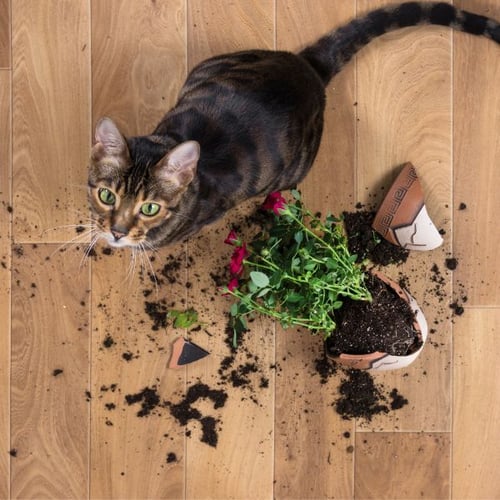
Make the Soil Unappealing to Your Cat
As mentioned above, cats are not huge fans of citrus. So, if you are spritzing leaves or fronds with a citrus solution (lemon, lime, or orange diluted with water), you can easily do the same thing for the soil.
Place a piece of landscape fabric or burlap spritzed with citrus to keep them from digging. Not only do you keep your cat away from your favorite greenery, but your home smells great too!
Another option is taking slices of the rind and placing those around the pot. But, keep an eye on your cat and make sure the scent isn’t causing them to avoid the room completely.
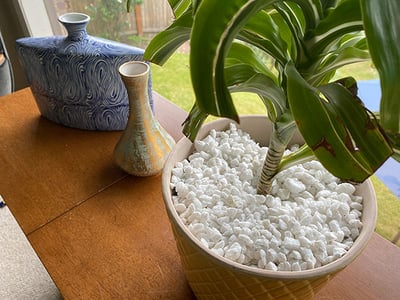
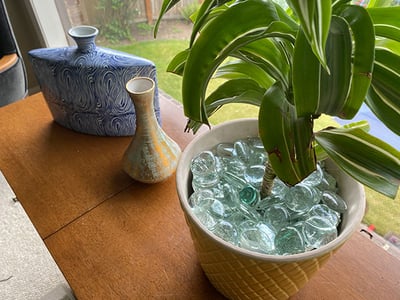
Cover the Soil
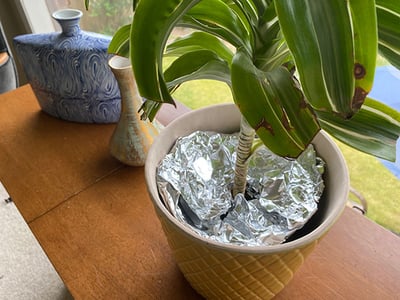
You can cover the soil with aluminum foil. Cats don't like the sound and feel of aluminum foil on their paws, so this can be a good deterrent. Foil can also be used during the holidays if you are having trouble keeping your cat out of your Christmas tree.
However, I don't find aluminum foil very attractive, so I like to use small decorative rocks. If you find they are batting the small pebbles around, switch to a slightly larger pebble with more weight. And consider esthetically how much nicer your plant will look with some stones at the base.
Sticky Paws tape is another great option. Get an inexpensive plastic placemat, cut it to the size of your pot to cover the soil, and attach the Sticky Paws. This creates a sticky surface your cat won’t want to walk on. Never use regular double-sided tape. You want to choose an option made specifically for cats.
If you're crafty you may be able to build your own stylish planter cover, but for those of us who need an artisan's help, this beautiful wooden planter cover on Etsy may be just what you need! There's still room for air flow and watering, and it should keep kitty paws away from the dirt.
Your goal is to make these areas less appealing to walk on or dig in, so your cat chooses to avoid them. But you never want to cause pain or undue stress. Avoid aversives like electric mats, motion-activated air bursts, or plastic spikes.
Why is My Cat Using a Planter as a Litter Box?
You don't have to look too far into why your cat is using a planter as a litter box. There are generally two reasons — and one probably has to do with the litter box that you bought for your cat.
It's Natural for Cats to Dig & Do Their Doody
As explained previously, cats naturally like to dig, especially in cold soft dirt. That's why you may find random surprises in your outside planters from your cats (if they are outdoor cats) or feral cats in the area.
They need somewhere to go, and what better place than your lovely flower garden! You can use the same techniques described above to make your planters undesirable. However, if your cat is using your inside planters as a litter box, it may be due to common litter box setup and maintenance mistakes.
Set Your Cat Up for Litter Box Success
We have an excellent article series called Litter Box 101 that goes into greater detail on how to set your cat up for litter box success. There are a couple of things to keep in mind when you are trying to understand why your cat is peeing or pooping in unwanted areas.
Again, it's important to FIRST ensure that your feline doesn't have any underlying medical condition resulting in unwanted messes around the house. You should always check with your veterinarian about any changes in your cat's litter box habits. After ruling out any medical issues, chances are your cat is probably not happy with their litter box situation.
- Cats Like a Clean Litter Box. This should go without saying, but how many times have we all forgotten to clean out the litter box? Or we asked our kids to do the daily scoop, and they forget? It happens, but if you aren't cleaning your cat's litter box regularly, they may be choosing to take their business elsewhere. You should clean the litter boxes every day. And you may have noticed that I wrote boxes, as in plural inside your home.
- You Need One More Box Than Your Number of Cats. You should have one more litter box than the number of cats you have in your home. So, one cat equals two litter boxes. Two cats equal three boxes, and so on.
If you have multiple levels, you should put a litter box on each level, as well. I don't know any humans that like having only one bathroom in their home, so imagine sharing a small box with someone else! No, thank you. - Size Matters When You're Buying a Litter Box. This is a common mistake made by many cat lovers because cats are so nimble. However, cats need room to do their doody. Cats can be very particular about the size, shape, depth, and other aspects of their litter box. Your cat's litter box should be big enough for them to move around freely.
As a general rule, the correct size litter box should be at least as long as your cat, from their nose to the tip of their tail (when extended). Its width should be at least as wide as your cat is long (with their tail not extended).
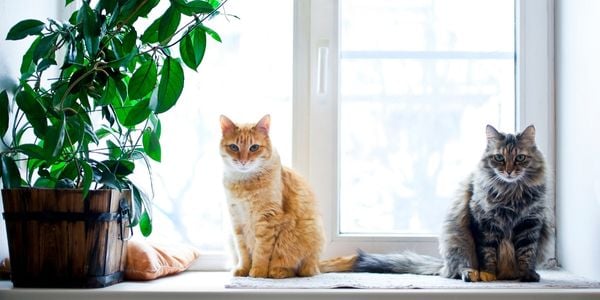
Hopefully, this gives you some options when trying to maintain a colorful home and a healthy cat! See what works for your situation and your cat's personality. It's still important to pay close attention to any abnormal behavior your cat may be showing after being around your non-toxic plants.
Although your plants may be safe for cats from a toxicity standpoint, your feline may consume enough of a leaf to cause an upset stomach. Depending on the leaf's shape and how much they eat, there's a risk of a possible gastrointestinal obstruction or even a foreign body in their nose.
Unusual Cat Behavior to Look Out For:
- Coughing
- Gagging
- Sneezing
- Vomiting
- Decreased appetite
- Pawing at mouth or nose
If you notice any of these symptoms or anything else concerning, contact your veterinarian immediately.
For additional information on plant and flower toxicity in cats, ASPCA's Animal Poison Control Center is a great resource.
Share your favorite tips or tricks to keep your cat out of your plants in the comments below!





